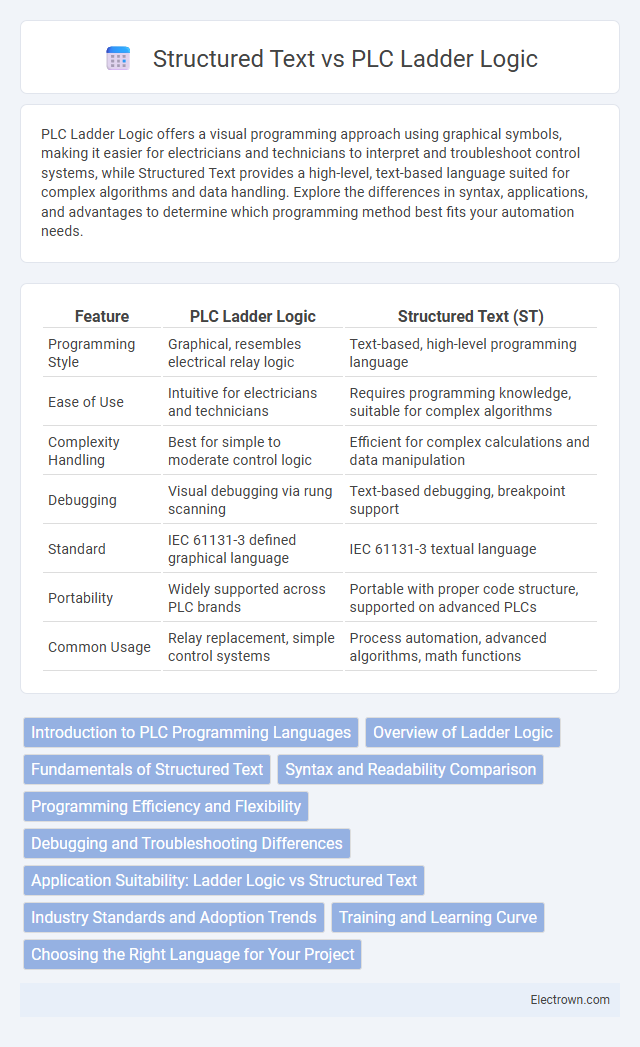PLC Ladder Logic offers a visual programming approach using graphical symbols, making it easier for electricians and technicians to interpret and troubleshoot control systems, while Structured Text provides a high-level, text-based language suited for complex algorithms and data handling. Explore the differences in syntax, applications, and advantages to determine which programming method best fits your automation needs.
Table of Comparison
| Feature | PLC Ladder Logic | Structured Text (ST) |
|---|---|---|
| Programming Style | Graphical, resembles electrical relay logic | Text-based, high-level programming language |
| Ease of Use | Intuitive for electricians and technicians | Requires programming knowledge, suitable for complex algorithms |
| Complexity Handling | Best for simple to moderate control logic | Efficient for complex calculations and data manipulation |
| Debugging | Visual debugging via rung scanning | Text-based debugging, breakpoint support |
| Standard | IEC 61131-3 defined graphical language | IEC 61131-3 textual language |
| Portability | Widely supported across PLC brands | Portable with proper code structure, supported on advanced PLCs |
| Common Usage | Relay replacement, simple control systems | Process automation, advanced algorithms, math functions |
Introduction to PLC Programming Languages
PLC Ladder Logic mimics electrical relay logic through graphical symbols, making it highly intuitive for technicians with electrical backgrounds and facilitating straightforward troubleshooting. Structured Text, a high-level programming language resembling Pascal, enables complex algorithms and data operations through textual code, offering greater flexibility and scalability in industrial automation projects. Both languages serve distinct purposes in PLC programming, with Ladder Logic excelling in simplicity and visualization, while Structured Text provides advanced control capabilities for sophisticated process management.
Overview of Ladder Logic
Ladder Logic is a visual programming language used extensively in industrial automation to design control systems resembling electrical relay logic diagrams. It provides an intuitive, graphical approach where you arrange rungs containing contacts and coils representing control processes, making troubleshooting and debugging easier. This method is highly effective for simple to moderately complex control tasks, offering clear visualization of logic operations in PLC programming.
Fundamentals of Structured Text
Structured Text (ST) is a high-level programming language used in PLCs, designed for complex control algorithms and data handling, utilizing syntax similar to Pascal or C. It supports structured programming elements such as loops, conditionals, and functions, enabling easier readability and maintainability compared to the graphical nature of Ladder Logic. ST is particularly advantageous for arithmetic operations, complex data manipulation, and tasks requiring iterative processes, making it ideal for advanced automation systems.
Syntax and Readability Comparison
PLC Ladder Logic uses graphical symbols resembling electrical relay circuits, making it intuitive for electricians and technicians familiar with wiring diagrams, enhancing readability through visual representation. Structured Text employs a high-level, text-based syntax similar to conventional programming languages like Pascal, offering greater flexibility for complex algorithms but requiring programming knowledge to interpret effectively. Your choice depends on whether visual clarity or advanced programming capabilities better suit the complexity and maintainability of your automation project.
Programming Efficiency and Flexibility
PLC Ladder Logic offers intuitive visual programming with easy-to-follow relay-like diagrams, making it ideal for straightforward control tasks and quick troubleshooting. Structured Text provides greater programming efficiency and flexibility through high-level language syntax, enabling complex algorithms, loops, and conditional statements that Ladder Logic struggles to handle. Your choice depends on the application complexity, with Structured Text excelling in advanced automation requiring modular, scalable code.
Debugging and Troubleshooting Differences
PLC Ladder Logic offers a visual representation of control processes, making debugging intuitive through monitored rung-by-rung execution and easily identifiable contacts and coils. Structured Text, being a high-level programming language, provides advanced debugging tools like breakpoints, step execution, and variable watches for more complex troubleshooting scenarios. Your choice depends on whether you prefer graphical simplicity with Ladder Logic or detailed, code-focused debugging capabilities in Structured Text.
Application Suitability: Ladder Logic vs Structured Text
Ladder Logic is ideal for simple to moderately complex control systems, especially in manufacturing environments where visual clarity and ease of troubleshooting are crucial. Structured Text excels in handling complex algorithms, data manipulation, and multi-tasking applications, making it suitable for advanced automation projects requiring high-level programming capabilities. Choosing between Ladder Logic and Structured Text depends on the application's complexity, required flexibility, and the programmer's familiarity with graphical versus text-based coding.
Industry Standards and Adoption Trends
PLC Ladder Logic remains the dominant programming language in industrial automation, especially in manufacturing sectors, due to its graphical interface closely resembling electrical relay logic, facilitating widespread adoption. Structured Text, standardized under IEC 61131-3, is increasingly adopted in complex control systems requiring advanced data handling, modularity, and scalability, favored in process industries and newer automation applications. Industry trends indicate a growing integration of Structured Text alongside Ladder Logic in hybrid programming environments to leverage the strengths of both languages in meeting evolving automation requirements.
Training and Learning Curve
PLC Ladder Logic offers a visually intuitive programming environment, making it easier for beginners and technicians with electrical backgrounds to learn and troubleshoot control systems rapidly. Structured Text requires familiarity with high-level programming concepts and syntax, which can present a steeper learning curve for novices but allows for greater complexity and flexibility in code development. Training often emphasizes Ladder Logic for entry-level roles, while Structured Text is preferred for advanced automation tasks demanding scalable and maintainable code structures.
Choosing the Right Language for Your Project
Selecting the right programming language for your automation project depends on complexity, readability, and maintenance requirements. PLC Ladder Logic excels in visual simplicity and is ideal for straightforward control systems, while Structured Text offers advanced functionality and better handling of complex algorithms or data manipulation. Your choice should align with project demands and team expertise to optimize efficiency and scalability.
PLC Ladder Logic vs Structured Text Infographic

 electrown.com
electrown.com